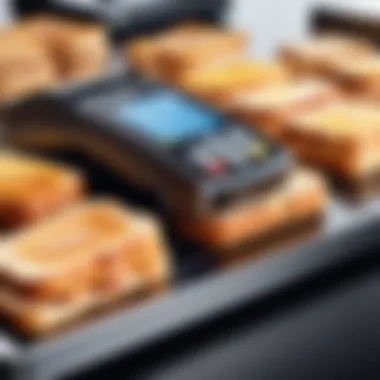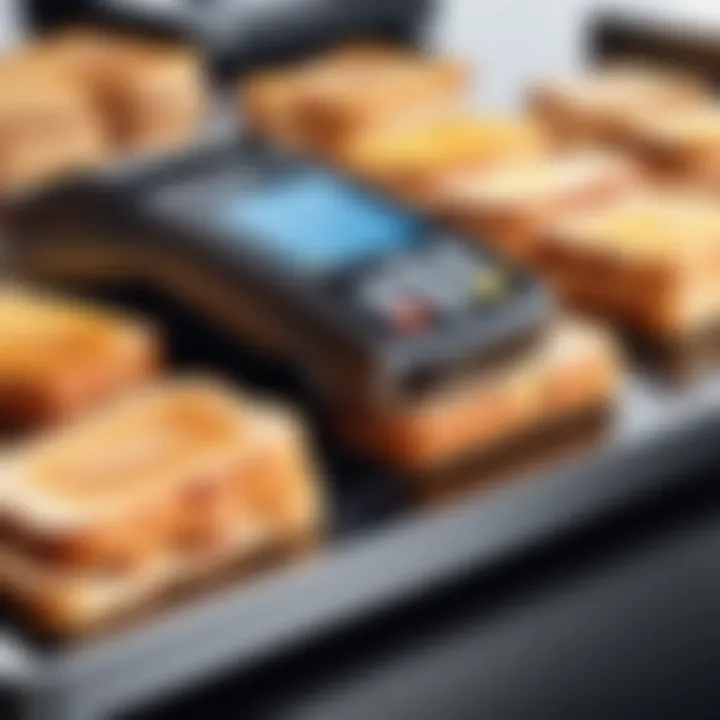Analyzing the Costs of Toast POS Hardware


Intro
In the ever-evolving landscape of the restaurant and retail sectors, the cost of adopting technology has become a pivotal factor in decision-making processes. Among such technology, Toast POS hardware stands out as a considerable investment for both new and established businesses. Grasping the complexity behind these costs can influence the direction of operational efficiency and financial planning. This guide will delve into the costs associated with Toast POS hardware, covering various layers from price variability to the total ownership expenditure.
Software Overview
Brief Description of Software
Toast is not just a point-of-sale (POS) system; it’s a holistic platform designed primarily for the food service industry. With an integrated approach, Toast combines payment processing, restaurant management tools, and customer engagement functionalities all under one umbrella. By leveraging cloud technology, it provides real-time data access, enabling owners to make quick, informed decisions.
Key Features and Functionalities
Some notable features that make Toast POS a strong contender in the marketplace include:
- User-Friendly Interface: Designed for ease of use, training staff takes mere minutes.
- Customizable Menus: Enables businesses to easily adjust offerings based on demand or seasons.
- Sales Reporting: In-depth analytics that allow businesses to track performance efficiently.
- Table Management: Streamlines reservations and table turnover, optimizing floor space.
- Customer Engagement Tools: Loyalty programs and promotional features to increase repeat business.
Detailed Comparison
Comparison with Competitors
When evaluating Toast POS, comparison with other systems like Square, Clover, or Lightspeed is inevitable. One might find that while these systems offer similar functionalities, Toast's integration with specific industry needs often tips the scale. For instance, its emphasis on the restaurant ecosystem, tailored features for kitchen staff, and online ordering capabilities are areas where it shines against peers.
Pricing Structure
Understanding Toast’s pricing requires breaking it down into several components:
- Initial Hardware Costs: This includes the purchase of terminals, printers, and tablets. Depending on the setup, businesses may spend anywhere from a few hundred to several thousand dollars.
- Monthly Software Fees: Toast typically operates on a subscription model, with various tiers available based on features utilized.
- Transaction Fees: There are costs associated with payment processing, often structured as a percentage of each transaction.
- Add-Ons: Extra services such as advanced reporting tools or premium customer support can add to the bottom line, making it crucial for decision-makers to assess actual needs.
"Investing in a reliable POS system is not merely about choosing the least expensive option; it’s about evaluating total costs against tangible benefits."
In sum, understanding the costs tied to Toast POS hardware does not solely involve understanding base prices but also recognizing functional enhancements that can lead to an increase in efficiency and profitability. Ultimately, a comprehensive understanding of these financial intricacies empowers professionals to make knowledgeable recommendations tailored to their clients' needs.
Foreword to Toast POS Hardware Costs
Understanding the costs associated with Toast POS hardware is not just a cursory examination of prices. It plays a crucial role in determining the viability of electronic point-of-sale systems for businesses of all sizes. As more establishments from diners to upscale restaurants opt for technology-driven solutions to streamline operations, grasping these costs becomes paramount.
The importance of this topic lies in the multifaceted nature of its expenses. Pricing extends beyond the initial outlay for equipment. Ongoing costs, such as maintenance, support, and software updates, must also be taken into account. By clearly assessing these various price elements, decision-makers can avoid unexpected financial strain down the road.
In addition to budgetary considerations, the choice of Toast POS equipment can significantly affect operational efficiency. When businesses invest wisely in the right hardware, it can lead to smoother transactions, better inventory management, and ultimately an improved customer experience. Moreover, understanding how each cost component interacts can aid businesses in predicting future expenses and in discussions during negotiations with vendors.
Here are some critical areas to consider when analyzing Toast POS hardware costs:
- Initial Investment: This includes touchscreen terminals, card readers, and printers, each with its own associated price tag.
- Recurring Expenses: Planning for ongoing costs such as software upgrades and customer support can help in building a more comprehensive financial strategy.
- Market Variability: Prices can change based on demand and technological advancements, making it even more essential to stay informed.
"A penny saved is a penny earned." This old adage rings especially true when it comes to investing in technology. Knowing the ins and outs of these costs might ultimately save businesses a significant amount in the long run.
In summary, an in-depth understanding of the costs surrounding Toast POS hardware can help entrepreneurs and decision-makers make informed choices, ensuring that investments align with their business strategies and financial goals.
Overview of Toast POS System
When discussing the costs associated with Toast POS hardware, it’s crucial to first grasp what the Toast POS system entails. Understanding the system not only provides insight into its functionalities but also sets a foundation for recognizing its value proposition in the restaurant and hospitality sectors. This overview will cover the system’s purpose, its benefits for businesses, and the considerations that come into play when evaluating its overall effectiveness.
What is Toast POS?
Toast POS is a cloud-based point-of-sale system tailored specifically for the food service industry. This system integrates various functionalities that streamline operations, enhance customer experience, and ultimately drive sales. Unlike generic POS systems, Toast is designed with the unique needs of restaurants, bars, and cafes in mind. It’s not just about processing transactions; it’s about offering a holistic solution that includes features like menu management, reporting, and even marketing tools.
Key Elements of Toast POS:
- Cloud-Based Infrastructure: This allows for constant updates, remote access, and reduces the barrier to entry concerning hardware costs.
- Customization Options: Users can tailor the system to fit their specific needs, from menu designs to payment processes.
- Integrated Payments: Toast provides a seamless payment experience, whether it’s credit cards, mobile payments, or gift cards.
Key Features of Toast POS
Diving deeper, the true strength of Toast POS lies in its feature set. Each component is built to address specific challenges that restaurants face.
- Menu Management: With Toast, operators can easily update menus across all locations in real time. This is particularly valuable for establishments that frequently alter their offerings based on seasonality or special promotions.
- Reporting and Analytics: The system provides extensive reporting tools to monitor sales patterns, track inventory, and understand customer behaviors. Operators can derive meaningful insights that allow for better decision-making.
- Table Management: This feature optimizes seating arrangements and improves the overall service speed by assisting staff in managing reservations and waitlists.
- Customer Relationship Management (CRM): By tracking customer preferences and order history, the Toast POS system helps build loyalty programs that can entice repeat business.
- Mobile Ordering: With the increase in digital transactions, the ability to cater to mobile orders ensures that businesses can adapt and meet customer demands effectively.
The gathered features echo a significant truth in the restaurant industry: a tailored POS system doesn’t merely handle transactions; it enhances operational efficiency and customer satisfaction.
In summary, the Toast POS system combines tools that are beneficial not just for immediate transactions but also for supporting strategic growth. For decision-makers, IT professionals, and entrepreneurs, understanding what Toast offers is pivotal in evaluating the total costs and benefits that the system brings to the table.
Components of Toast POS Hardware


Understanding the various components of Toast POS hardware sheds light on how each piece contributes to the overall functionality and effectiveness of the system. Each element, from touchscreen terminals to scanners, has its own set of implications in terms of cost, usability, and ultimately, how it influences customer satisfaction. A well-rounded perspective on these components will help decision-makers make strategic investments that align with their business objectives.
Touchscreen Terminals
Touchscreen terminals serve as the hub of the Toast POS system. They’re user-friendly, allowing staff to input orders swiftly, which can significantly enhance the pace at which customers are served. These devices often boast vibrant displays that can also showcase marketing visuals, making them not just functional but also appealing.
When considering costs, touchscreen terminals can vary greatly. The price is influenced by size, technology, and whether they're standalone or part of a larger integrated system. Investing in quality touchscreen terminals can reduce training time for new employees — an often overlooked factor that can save money in the long run. Consider it this way: if staff can navigate the system with ease, they spend less time fumbling and more time providing exemplary service.
Card Readers
With the rise of contactless payments, card readers have become an essential part of any modern POS system. Toast POS hardware offers robust card readers that not only securely process transactions but also support various payment methods, including mobile wallets like Apple Pay or Google Pay. This versatility is pivotal, especially as consumer preferences shift.
From a cost perspective, the pricing depends on the technology used in the card readers. For instance, advanced models that handle EMV and NFC transactions might cost more but significantly reduce fraud risk, which is a strong selling point. Many businesses often grapple with the initial outlay versus long-term security benefits — it’s a balance of upfront vs ongoing costs that shouldn’t be ignored.
Printers
Printers in the Toast POS ecosystem serve various purposes, including order tickets for the kitchen, receipts for customers, and promotional materials. The quality of the printer impacts not only productivity but also the customer’s experience. Imagine a scenario where a receipt printer fails during a busy rush hour; it’s chaos that could easily have been prevented by selecting a reliable device.
When looking at costs, consider different types: thermal printers tend to be cheaper and require less maintenance than impact printers. However, thermal printers involve recurring costs for paper rolls, which can add up over time. Therefore, evaluating the cost of consumables in conjunction with the hardware itself is crucial for an accurate total cost assessment.
Scanners
Scanners enhance the efficiency of the Toast POS system by quickly processing barcodes for inventory management, sales, and reporting. They streamline procedures, particularly in busy environments like restaurants or retail, where speed is essential. A well-functioning scanner minimizes human error and can lead to improved stock management, thereby decreasing wastage — an important consideration for any business.
In terms of expense, various models come with different capabilities. Handheld models may be affordable at first, but fixed scanners often offer advanced features, which could be more beneficial for high-volume businesses. Scrutinizing the specific needs of your business process is essential when deciding on scanner investments.
Overall, the components of Toast POS hardware work together to provide a seamless experience for both staff and customers. Understanding the associated costs and implications of each element ensures that decision-makers are equipped with knowledge to foster optimal operation and profitability.
Initial Costs of Toast POS Hardware
When discussing the acquisition of Toast POS hardware, one might underestimate the significance of understanding initial costs. Grasping these upfront expenditures is crucial, given that they can heavily influence a business's bottom line. These costs lay the foundation for any investment decisions. For many establishments, especially in the hospitality sector, the choice to switch or invest in a new POS system can mean the difference between smooth operations and financial strain.
The initial costs of Toast POS hardware consist of several elements, each contributing to the overall price tag. It's more than just the buying price of the equipment; there's installation, potential training costs for staff, and connecting to necessary services. This section will dive deeper into the cost breakdown and also compare these figures to other installations in the market, providing a clearer picture for decision-makers and planners. After all, it's not just about what you pay today, but understanding how those expenses resonate in the long run.
Cost Breakdown by Component
The initial costs associated with Toast POS hardware naturally vary based on the specific components involved in the setup. Let’s break it down:
- Touchscreen Terminals: The heart of the operation, prices here can range based on model and features. While a basic touchscreen terminal might start around $1,500, more advanced models with added functionalities could cost upwards of $3,000.
- Card Readers: These devices allow customers to pay using cards. The expected pricing will generally be around $200 to $500 depending on integration and capabilities, like chip reading or contactless payments.
- Printers: Essential for paper receipts and kitchen orders, thermal printers run about $250 to $500 each.
- Scanners: Often necessary in retail settings, scanners can be acquired for roughly $100 to $300, adding another layer of functionality to the POS system.
These individual components can add up quickly. Taking this into account, a small business could easily find themselves facing anywhere from $5,000 to $10,000 for a comprehensive setup, depending on how robust they want the system to be.
Comparative Analysis with Other POS Systems
While Toast POS has its unique offerings, comparing its initial costs with other POS systems is invaluable. For instance, some alternatives in the market, like Square or Clover, might come with a lower initial investment, typically starting around $2,000 for basic setups. However, it's essential to weigh more than just upfront costs.
Toast is known for robustness and dedicated service in the restaurant space, which might justify a higher initial investment. For example:
- Square: While it presents an appealing upfront price, some users find that transaction fees quickly accumulate, potentially raising long-term costs.
- Clover: This system may offer varied pricing depending on the packages selected, but often at the cost of less comprehensive service compared to Toast.
In terms of support and integration, Toast often shines with a service-focused approach that some competing systems lack. This factor might bring value that compensates for higher initial costs, ultimately benefiting those committed to delivering excellent customer experiences.
Therefore, while the initial financial outlay for Toast might seem steep, decision-makers must consider the overall cost of ownership and operational advantages these systems can bring over time.
Factors Influencing Toast POS Hardware Costs
The expenses associated with Toast POS hardware are hardly set in stone. They are influenced by several key factors that can have a significant impact on how much a business ultimately spends. Understanding these elements is crucial for decision-makers, IT professionals, and entrepreneurs as it allows them to navigate the financial landscape of acquiring and maintaining POS systems effectively. Being aware of these influencing factors can facilitate better budgeting and planning, thereby equipping businesses to make informed decisions.
Volume of Orders
The volume of transactions a business processes is one of the primary drivers of Toast POS hardware costs. More orders typically mean a need for more robust hardware to handle the increased demand. For instance, a bustling restaurant with high foot traffic might require additional terminals, whereas a seasonal food truck might only need a single unit. Investing in hardware that scales with transaction volume can prevent future inefficiencies and provide a smoother operational flow.
- Higher Capacity: More terminals or machines may be necessary to keep up with peak times.
- Technological Efficiency: Devices designed for high throughput can reduce lag, ensuring that service isn’t compromised during busy hours.
- Long-term Planning: Companies should aim to anticipate growth when budgeting for these expenses to avoid costly upgrades later on.
In summary, the volume of orders is a vital consideration, as it not only influences the initial investment but also impacts how businesses can operate on a day-to-day basis.
Customization Needs
Customization plays a distinct role in determining the cost of Toast POS hardware. Some businesses have unique operating systems that require tailored solutions. Custom hardware can make the POS system operate more effectively, but it often comes at a premium.
- Tailored Solutions: Businesses with specific needs, like inventory management or customer relations, might require customized setups.
- User Experience: Custom-fitting features can enhance employee efficiency, providing interfaces that cater to specific roles.
- Integration Costs: If a company has existing software or hardware, making everything work together can lead to increased expenses.


Deciding how much customization is necessary hinges on evaluating business processes and identifying pain points. Investing in well-suited hardware early on can save money in the long run by minimizing inefficiencies.
Market Conditions
The state of the market can drastically alter the cost dynamics associated with Toast POS hardware. Factors like economic climate, competition among suppliers, and technological advancement can dictate prices.
- Demand and Supply: High demand for quality POS systems might drive prices up, while increased competition can push them down.
- Technological Developments: As technology evolves, older models may reduce in price, while the latest hardware could demand a premium.
- Economic Trends: In times of economic downturn, hardware suppliers might offer discounts to stimulate sales, benefiting end users.
Staying abreast of market trends is essential for anyone looking to invest in Toast POS solutions. Understanding prevailing conditions can help businesses time their purchases to get the best deals possible.
Long-Term Cost Considerations
When it comes to investing in toast POS hardware, understanding the long-term costs is not just a walk in the park; it’s akin to navigating a maze. It’s crucial to evaluate these costs throughout the lifespan of the system. Various elements can have significant impacts on expenses over time, affecting the overall investment. This section aims to untangle those intricacies, providing a clear perspective for those who hold the reins of decision-making in their hands.
Maintenance and Support
One of the front-line expenses that many businesses often overlook is the ongoing maintenance and support. Why is this crucial? Because toast POS systems are not just a one-and-done deal. Like any piece of technology, these systems require regular upkeep. This means budget considerations must include:
- Software Updates: Regular updates ensure the system runs smoothly, stays secure, and incorporates new features. Staying current can help avoid potential downtime or security threats.
- Technical Support: Having access to customer service or technical support can save a good chunk of change in the long run, especially when issues arise unexpectedly.
- Physical Maintenance: Hardware tends to wear out. Regular checks and any repairs needed will inevitably pile up on the cost sheet. Plan for these expenses rather than being caught off guard.
Investing in a maintenance plan can ease the financial burden. Many vendors offer packages that cover these essentials, potentially saving money as compared to paying for each service a la carte.
Upgrades and Replacements
As technology moves along at a breakneck pace, the likelihood of needing upgrades or replacements becomes increasingly prevalent. Here are some pointers to consider:
- Hardware Upgrades: Standalone devices may need enhancements or replacements as the business grows or as technology evolves. Think bigger stores or more customer interactions—systems that once sufficed might require better components.
- Software Enhancements: Newer versions of POS software can bring additional features, higher efficiency, and better security. However, keeping up with these updates could lead to additional expenses after initial installation.
- Vendor Policies: Some vendors provide trade-in offers or discounts for upgrades, which can alleviate costs. Others, however, leave businesses holding the bag for full price on newer models.
Here, it's not just about throwing money at problems as they arise; it's about strategy. Regular assessments of your system's performance can guide timely upgrades that align with ongoing requirements.
Total Cost of Ownership
To put all the pieces together, one must delve into the total cost of ownership (TCO) of the POS hardware. This is essentially the sum of all costs involved in acquiring, using, and maintaining the hardware over its useful life. TCO takes into account:
- Initial Purchase Costs: What you pay upfront, including the hardware, software, and any initial setup assistance.
- Operational Costs: This amounts to all the day-to-day costs, such as utilities and labor associated with operating the system.
- Hidden Costs: These can often include unexpected repairs, downtime costs, and indirect costs associated with not having an operational POS when needed.
"The best way to predict the future is to create it."
Calculating and tracking the TCO offers an insightful lens into long-term investments and helps justify spending decisions, ensuring resources are allocated wisely. By understanding these parameters, management can foresee financial ramifications and better prepare for a sustainable operational strategy.
Financial Models for Acquiring Toast POS Hardware
Understanding the financial models available for acquiring Toast POS hardware is crucial for businesses considering implementing this system. These models not only determine the upfront and long-term costs but also help in aligning the investment with the company’s cash flow and operational strategy. Choosing the right financial model can have significant implications for budgeting, tax benefits, and overall financial health of the organization. This section will delve into the main financial strategies: purchasing outright or leasing the equipment, along with available financing options.
Upfront Purchase vs. Leasing
Acquiring Toast POS hardware can largely be categorized into two models: outright purchase or leasing. Each method comes with its unique benefits and drawbacks.
Upfront Purchase
When a business opts for an outright purchase, it pays the total costs of the hardware at the start. This model offers complete ownership, providing flexibility for customizations and modifications. Some of the key advantages include:
- Asset Ownership: Full ownership allows businesses to modify, upgrade, or sell the equipment at their discretion.
- Tax Deductibility: Companies can often write off the full cost of the equipment in the year of purchase, which can lead to significant tax savings.
- Cost-Effectiveness in the Long Run: While the initial outlay might be large, over time the total cost can be lower compared to leasing, especially if the equipment has a long lifespan.
However, there are downsides:
- Higher Upfront Costs: The immediate financial burden can strain budgets, particularly for smaller businesses.
- Obsolescence Risk: Technology can become outdated quickly, making it possible for the business to be stuck with unneeded equipment.
Leasing
On the flip side, leasing the equipment can be an attractive option, especially for businesses looking to maintain more flexibility in their operations. The major benefits include:
- Lower Initial Costs: Leasing typically requires a smaller down payment compared to purchasing, easing the initial financial strain.
- Updated Technology: Leases often allow for periodic upgrades, keeping the business equipped with the latest technology without extra costs.
- Predictable Monthly Expenses: Leasing offers a steady monthly payment which aids in budgeting and planning.
However, leasing does pose its own challenges:
- No Ownership: Since the equipment is not owned, any modifications or installations may be limited or could incur extra charges.
- Long-Term Costs: Over an extended period, the total payments can surpass that of an outright purchase, especially if the lease is prolonged.
Financing Options Available
Apart from the basic models of purchase and leasing, businesses may explore different financing options catering to their specific needs. Some common methods include:


- Traditional Bank Loans: Banks often provide loans specifically for business equipment. This can flow capital into the business while mitigating upfront costs. Interest rates vary widely, so careful comparisons are necessary.
- Equipment Financing: Some companies specialize in equipment loans where the hardware itself serves as collateral. This often results in better terms than a standard loan.
- Vendor Financing: Some vendors may offer their own financing options, enabling the purchase of hardware through tailored payment plans. This can simplify the process, keeping everything within the ecosystem of the POS system.
- Crowdfunding Options: Newer avenues like crowdfunding can help raise capital, though the success of this approach may be dependent on broader engagement strategies.
- Business Credit Cards: For businesses with strong credit, purchasing equipment on a credit card with 0% financing for an introductory period can be another way to manage costs, provided the balance is paid off before the rate changes.
Determining whether to purchase or lease Toast POS hardware is about finding the right balance between cash flow, operational flexibility, and total cost effectiveness.
As decision-makers reflect on these models, they must remember that the financial strategy chosen can significantly impact their operational efficiency and cash flow. Whether through upfront purchases or leasing agreements, each avenue holds potential pitfalls and rewards, necessitating a thorough evaluation based on the business’s unique needs.
Case Studies of Toast POS Implementation
When we dive into the practical realm of Toast POS implementation, we find that real-world examples offer a richer understanding than just theory. Case studies shine a light on how various businesses effectively navigate the often murky waters of adopting new systems, especially in the hospitality sector. Through examining these implementations, stakeholders—like decision-makers and IT professionals—gain important insights into the costs and benefits tied to using Toast POS hardware.
One significant aspect of case studies is the illustration of specific challenges faced by businesses. Different establishments have unique needs and contexts. A small café might contend with limited IT support, while a bustling restaurant chain could emphasize scalability and integration within a larger ecosystem. These narratives encapsulate the very essence of Toast POS, exposing the intricacies of deployment and long-term utilization.
Small Business Deployments
In the small business arena, the Toast POS system has been a game changer. Let's look at a cozy bistro located in a vibrant neighborhood. Upon implementation, this bistro quickly recognized a few key benefits that significantly outweighed the associated costs.
- Streamlined Operations: In just a few weeks, management noted a marked improvement. The integrated system simplified order-taking and payment processes, boosting both staff productivity and customer satisfaction.
- Cost-effectiveness: Initial investments in hardware were lower than other systems available at the time, making it feasible for a small establishment operating on tight margins.
- Support and Training: The company provided substantial training materials and responsive technical support, which eased the transition. Owners often remarked about how Toast empowered their staff rather than complicating workflows.
However, the transition wasn't entirely smooth. Every silver lining has a cloud, and these small businesses had to grapple with a few challenges:
- Adaptation Time: While the system is user-friendly, staff still needed time to adjust fully, which occasionally led to confusion during busy hours.
- Upfront Costs: Even though the long-term savings were observable, the initial expenses were still significant for owners with constrained budgets.
Overall, smaller deployments have highlighted that when implementing Toast POS, the return on investment is often seen after a handful of months, especially as these businesses refine their operations.
Medium Enterprise Deployments
Conversely, when examining medium enterprise deployments, the narrative changes a bit. Consider a regional restaurant group with multiple locations. They had distinct requirements for scale and extensive functionality. Through their experience with Toast POS, several important takeaways emerge:
- Scalability: As this group expanded into new markets, the POS system's ability to adapt became their cornerstone. The ease with which they could integrate additional terminals across locations facilitated seamless growth.
- Data Insights: With increased sales volume, the analytics features provided crucial insights into customer preferences and inventory management, enabling data-driven decisions that optimized profits.
- Centralized Management: The allure of managing multiple sites from a single dashboard turned out to be a game changer, allowing managers to oversee operations without being physically present at each location.
However, it wasn't all cherry blossoms and sunshine. The challenges they faced included:
- Initial Setup Complexity: The deployment process was more complex compared to single-unit businesses, requiring a dedicated IT staff to manage installations and software integrations across venues.
- Cost Considerations: Medium enterprises often confront higher costs, both upfront and ongoing, due to the necessity of purchasing advanced features and maintaining multiple systems, making careful budgeting crucial.
Best Practices for Advising Clients on Toast POS Hardware
Navigating the world of Toast POS hardware can be tricky for those who want to make informed choices. As industry advisors and decision-makers, understanding best practices not only aids in advising clients but also ensures that their investments yield substantial returns. Having a solid grasp of these practices can mean the difference between a thriving business and one that struggles to keep pace.
Evaluating Business Needs
When it comes to implementing a Toast POS system, one of the first things to consider is the specific needs of the business. This means taking a deep dive into the daily operations and understanding how the hardware will be utilized. Here are some pointers to guide the evaluation:
- Analyze Business Size: A small café might need just one terminal, while a large restaurant might require multiple setups.
- Identify Transaction Volume: Consider the peak hours and average customer volume. A busy time may require faster processing.
- Customization Requirements: Each business has unique offerings. Ensure the hardware can adapt to any menu or service changes.
It's like fishing without a rod; if you don’t know what you’re fishing for, the chances are slim you’ll catch anything worthwhile. Customization isn’t just an option; it’s often a necessity that can influence costs significantly.
Negotiation Tips for Pricing
Securing the best deal on Toast POS hardware often involves more than just asking for a lower price. A savvy negotiation strategy can provide not only a better price but also additional features or support. Here are some effective tactics to employ:
- Research Competitors: Before jumping into negotiations, it helps to gather info about competing offers. This enables you to make a stronger case for better pricing.
- Bundle Deals: Manufacturers or resellers often provide discounts when multiple systems or components are purchased together. Propose a bundled purchase to lower costs.
- Timing Transactions: Vendors might be more willing to negotiate during off-peak times. Understanding their sales cycles can be advantageous.
- Ask About Warranty and Support: Sometimes the best deal isn't just about the upfront price. Inquire about warranty terms—all the support comes at a cost, and better offers can save clients money in the long run.
Using these negotiation tips can empower advisors to find compelling offers that align with their client's needs, paving the way for a smooth implementation of Toast POS systems.
"Effective advising involves the art of listening as much as it does the art of speaking. Evaluating needs and negotiating prices is as much about understanding and empathy as it is about dollars and cents."
With these best practices in hand, advisors can better support clients in making informed decisions that will stand the test of time. Understanding business needs and mastering negotiation tactics ensures that clients are not just making a purchase but investing in a solution tailored to elevate their operations.
The End and Future Outlook
Understanding the costs associated with Toast POS hardware is not simply about numbers; it's about making concrete choices that can define the success of a business. In a world that thrives on adaptability, being well-versed in the financial aspects of technology is paramount. Deciding on the right hardware requires a holistic view of expenses, from initial investments to ongoing maintenance and upgrades. This article has provided insights into how each component contributes to the overall cost, positioning decision-makers to formulate clear strategies that suit their unique requirements.
In the realm of POS systems, knowing how to evaluate these costs gives businesses a competitive edge. It allows stakeholders to engage in informed discussions, ensuring that all financial decisions align with the organization's long-term goals. Moreover, keeping an eye on future trends can prepare businesses not just for today but for what lies ahead.
Additionally, while evaluating costs, it’s crucial to consider the changing landscape of marketplace dynamics. The rising need for integrated solutions, especially in light of the surge in e-commerce, requires forward-thinking strategies. This article aims to serve as a robust framework that goes beyond mere understanding, empowering professionals to navigate the complexities involved in selecting the Toast POS system.
Summarizing Key Takeaways
- Identifying the costs clearly and comprehensively can significantly aid in making informed choices.
- Each component of the Toast POS system influences the pricing structure, and understanding this is essential.
- Engaging with finances should be an ongoing process rather than a one-off task, with regular reviews and updates.
- As market needs evolve, adaptability in strategy becomes increasingly crucial.
Future Trends in POS Hardware Costs
Anticipating future trends concerning POS hardware costs enables businesses to position themselves for growth. As technology continues to advance, key areas to watch include:
- Integration with Cloud Services: With cloud computing on the rise, companies integrating these services into their POS systems might see a shift in cost structures.
- Rise of Subscription-Based Models: More suppliers may offer subscription-based pricing, potentially lowering initial costs while increasing long-term expenses.
- Emphasis on Security Features: As cyber threats become more sophisticated, investing in robust security features will likely factor into hardware costs.
- Customization Options: Increasing demand for tailored solutions could lead to greater cost variability, as businesses seek hardware suited to their specific needs.
Staying ahead of these trends can help companies not only budget effectively but also select systems that will grow alongside their evolving requirements.







